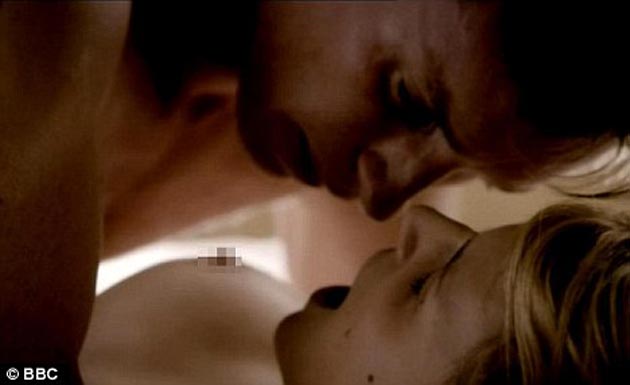 We
We’ve been watching quite a lot of frantic sex in our house over the past few weeks. It happens every year at this time, when BAFTA- the film and TV society for us professionals- begins counting the votes for its annual awards ceremony in February, and DVDs of the latest movies are delivered to its 6,500 voting members.
In this manner, the modern way of sex has been reaching me, as a BAFTA member, for many eye-popping years — along with the usual adventures of spies, detectives, criminals, vampires, wizards and talking toys.
But is sex today really like this? Somehow I doubt it. I mean, if everyone in the country was having sex the way it’s portrayed in most movies my wife Plum and I have been watching recently, it would suggest we’re living among a nation of super-athletes.
And a look at any bus queue tells us we’re not.
Back in the Thirties, Hollywood’s Motion Picture Production Code demanded that in all bedroom scenes one foot must stay on the floor at all times.
As that was impossible for anyone but a couple of contortionists, it was, of course, never tried — as was the code’s intention. Thus, there was no sex on screen.
Then in the Fifties, we got the Doris Day and Rock Hudson romantic type of comedies in which young, attractive, married couples in pyjamas would climb into twin single beds and, after a couple lines of snappy dialogue, put out the bedside light and go to sleep.
If anything, that was even more unlikely. But was it any more foolish than the way movie sex is now portrayed, where the actors seem to have been given the direction ‘Bonk as though your life depended on it, as athletically as you can, and we’ll add all kinds of exaggerated sounds to make it even more exciting’?
So were these the instructions given to Daniel Craig before he and that Girl With The Dragon Tattoo went at it with such gusto? Or to Michael Fassbender before he pretended to do similar things with all manner of people and in all kinds of manic ways in his new film Shame?
Admittedly, Fassbender was playing a sex addict, so I suppose some over-diligence might be expected in his case. But the bed crashing, the pulsating gasps, the sound effects magnified till almost off the register and the naked prostitute being addressed against a plate-glass window halfway up a glass tower block?
I’ve seen a lot of tower block windows in my life, but I’ve never seen that happening against one of them. I didn’t believe it, and I didn’t care. And when you don’t believe in a movie, it doesn’t work.
For the same reason, I didn’t believe last year’s champion in the over-athletic bonking stakes. That was Julianne Moore in the film The Kids Are All Right.
It was absurd that her character — a lesbian — would suddenly get such a heterosexual rush of desire for Mark Ruffalo that she went into what looked like frenzied, comic mortal combat with the guy.
I suppose the thinking behind such exaggerated displays of passion has taken its lead from the porn industry: the more torrid the scene, and the more we see and hear, the more entertained we’ll be — like actress Kristen Wiig’s ‘comic’ send-up of various raunchy positions in the film Bridesmaids.
It seems to me that for sex scenes to really work as the film-makers intend, the viewer has to identify with the characters and the emotions being depicted. Like porn, sex as a spectator sport can quickly become boring
Despite the legend it has since acquired, it was tedious in the first of the much over-hyped Hollywood bonkathons Don’t Look Now, which showed Julie Christie and Donald Sutherland at it like over- intimate wrestlers.
That was in 1973, but it had become downright ridiculous by the Nineties when Jeremy Irons acted out his trysts with Juliette Binoche in Damage.
The scenes of him banging the lady’s head on the floor mid-passion were neither romantic nor erotic. People in the cinema where I saw it laughed out loud. I wondered whether it should have been retitled Brain Damage.
Obviously, viewers like to see attractive people without their clothes on, be it in films, advertisements or on canvas. That’s just the way we humans are.
But by turning sex on screen into a display of ludicrous strength, energy and suppleness — with added sound effects — it seems the entire point is being lost.
Which brings me to an example of where it worked rather better: Birdsong, the BBC’s adaptation of Sebastian Faulks’s tale of love, infidelity and World War I. Yes, there was a lot of rolling around between starched white sheets and the odd peep at the unembarrassed breasts of beautiful French actress Clémence Poésy, but there were no gymnastics.
There didn’t need to be. Having watched the two main characters catching each other’s eyes and touching ankles, we were as much in love with the idea of them being in love — or, at least, in an enhanced state of mutual lust — as the couple on screen. That’s how it is, or was, some of us may remember.
In other words we, the audience, were not just uninvolved voyeurs of the passion, we felt we were part of it.
Now, I know at my time of life, or indeed at any time of my life, I never looked much like British actor Eddie Redmayne, but watching Birdsong on Sunday I felt it was me that Clémence Poésy was looking at with those extraordinary eyes.
And I’m pretty sure there were a few million married ladies around the country who were thinking what she seemed to be thinking as she gazed at young Eddie.
That’s the magic of romance on the screen when it’s done right. Obviously, the Birdsong adaptation was just upmarket, literary Mills & Boon really — pretty people, gorgeous French setting, impossible desire, all those clothes to take off . . . and so on.
But it seems that, at heart, most viewers (with, perhaps, the exception of hormonal teenage boys with their Inbetweeners comic smut) are a lot closer to Mills & Boon in their romantic fantasies than to Hollywood’s utilitarian bonkathons.
And as someone who sees an awful lot of athleticism masquerading as desire on screen whenever the BAFTAs come around, it’s a rather welcome relief.
# Ray Connolly’s novel Shadows On A Wall, about the making of a Hollywood movie, has just been republished as an eBook for Kindle. Source: The Daily Mail
 We’ve been watching quite a lot of frantic sex in our house over the past few weeks. It happens every year at this time, when BAFTA- the film and TV society for us professionals- begins counting the votes for its annual awards ceremony in February, and DVDs of the latest movies are delivered to its 6,500 voting members.
We’ve been watching quite a lot of frantic sex in our house over the past few weeks. It happens every year at this time, when BAFTA- the film and TV society for us professionals- begins counting the votes for its annual awards ceremony in February, and DVDs of the latest movies are delivered to its 6,500 voting members.